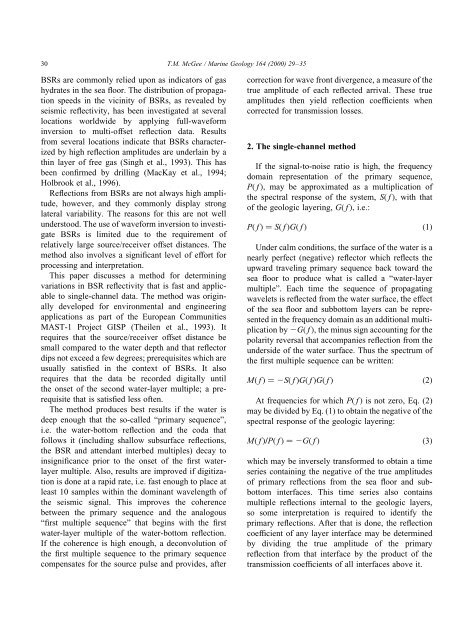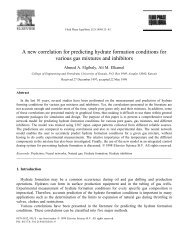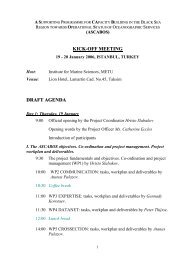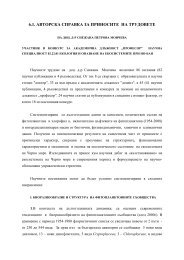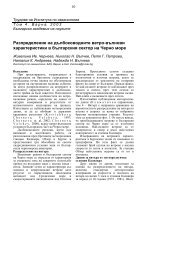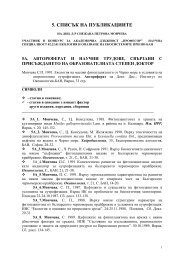A single-channel seismic reflection method for quantifying lateral ...
A single-channel seismic reflection method for quantifying lateral ...
A single-channel seismic reflection method for quantifying lateral ...
Create successful ePaper yourself
Turn your PDF publications into a flip-book with our unique Google optimized e-Paper software.
30T.M. McGee / Marine Geology 164 (2000) 29–35BSRs are commonly relied upon as indicators of gashydrates in the sea floor. The distribution of propagationspeeds in the vicinity of BSRs, as revealed by<strong>seismic</strong> reflectivity, has been investigated at severallocations worldwide by applying full-wave<strong>for</strong>minversion to multi-offset <strong>reflection</strong> data. Resultsfrom several locations indicate that BSRs characterizedby high <strong>reflection</strong> amplitudes are underlain by athin layer of free gas (Singh et al., 1993). This hasbeen confirmed by drilling (MacKay et al., 1994;Holbrook et al., 1996).Reflections from BSRs are not always high amplitude,however, and they commonly display strong<strong>lateral</strong> variability. The reasons <strong>for</strong> this are not wellunderstood. The use of wave<strong>for</strong>m inversion to investigateBSRs is limited due to the requirement ofrelatively large source/receiver offset distances. The<strong>method</strong> also involves a significant level of ef<strong>for</strong>t <strong>for</strong>processing and interpretation.This paper discusses a <strong>method</strong> <strong>for</strong> determiningvariations in BSR reflectivity that is fast and applicableto <strong>single</strong>-<strong>channel</strong> data. The <strong>method</strong> was originallydeveloped <strong>for</strong> environmental and engineeringapplications as part of the European CommunitiesMAST-1 Project GISP (Theilen et al., 1993). Itrequires that the source/receiver offset distance besmall compared to the water depth and that reflectordips not exceed a few degrees; prerequisites which areusually satisfied in the context of BSRs. It alsorequires that the data be recorded digitally untilthe onset of the second water-layer multiple; a prerequisitethat is satisfied less often.The <strong>method</strong> produces best results if the water isdeep enough that the so-called “primary sequence”,i.e. the water-bottom <strong>reflection</strong> and the coda thatfollows it (including shallow subsurface <strong>reflection</strong>s,the BSR and attendant interbed multiples) decay toinsignificance prior to the onset of the first waterlayermultiple. Also, results are improved if digitizationis done at a rapid rate, i.e. fast enough to place atleast 10 samples within the dominant wavelength ofthe <strong>seismic</strong> signal. This improves the coherencebetween the primary sequence and the analogous“first multiple sequence” that begins with the firstwater-layer multiple of the water-bottom <strong>reflection</strong>.If the coherence is high enough, a deconvolution ofthe first multiple sequence to the primary sequencecompensates <strong>for</strong> the source pulse and provides, aftercorrection <strong>for</strong> wave front divergence, a measure of thetrue amplitude of each reflected arrival. These trueamplitudes then yield <strong>reflection</strong> coefficients whencorrected <strong>for</strong> transmission losses.2. The <strong>single</strong>-<strong>channel</strong> <strong>method</strong>If the signal-to-noise ratio is high, the frequencydomain representation of the primary sequence,P… f †; may be approximated as a multiplication ofthe spectral response of the system, S… f †; with thatof the geologic layering, G… f †; i.e.:P… f †ˆS… f †G… f †…1†Under calm conditions, the surface of the water is anearly perfect (negative) reflector which reflects theupward traveling primary sequence back toward thesea floor to produce what is called a “water-layermultiple”. Each time the sequence of propagatingwavelets is reflected from the water surface, the effectof the sea floor and subbottom layers can be representedin the frequency domain as an additional multiplicationby G… f †; the minus sign accounting <strong>for</strong> thepolarity reversal that accompanies <strong>reflection</strong> from theunderside of the water surface. Thus the spectrum ofthe first multiple sequence can be written:M… f †ˆS… f †G… f †G… f †…2†At frequencies <strong>for</strong> which P… f † is not zero, Eq. (2)may be divided by Eq. (1) to obtain the negative of thespectral response of the geologic layering:M… f †=P… f †ˆG… f †…3†which may be inversely trans<strong>for</strong>med to obtain a timeseries containing the negative of the true amplitudesof primary <strong>reflection</strong>s from the sea floor and subbottominterfaces. This time series also containsmultiple <strong>reflection</strong>s internal to the geologic layers,so some interpretation is required to identify theprimary <strong>reflection</strong>s. After that is done, the <strong>reflection</strong>coefficient of any layer interface may be determinedby dividing the true amplitude of the primary<strong>reflection</strong> from that interface by the product of thetransmission coefficients of all interfaces above it.


